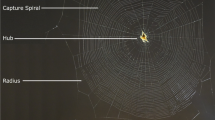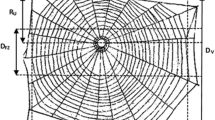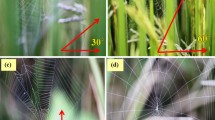Abstract
We studied the abilities of the garden cross spider Araneus diadematus regarding adaptation of web geometry to spatial constraints. Spiders reacted to a spatial reduction in their building site from a square-shaped frame to a slimmer, rectangular frame (side ratio 1 : 2) by maintaining overall web geometry while reducing the web area covered by the sticky capture spiral. However, when the frames were changed further to a rectangular side ratio of 1 : 3, the spiders changed specific web properties in such a way that a further reduction in the capture spiral area was prevented. Construction of the threads making up the web frame and the auxiliary spiral requires that the spider explores the spatial constraints of its building site. The geometry of both frame and auxiliary spiral threads in turn determine the geometry of the capture threads. Since in very narrow frames the spider adjusted the auxiliary to suit the subsequent capture spiral, we suggest that an initial spatial survey led to the final adaptation of overall web geometry to a web site.
Similar content being viewed by others
Author information
Authors and Affiliations
Additional information
Received: 26 April 1999 / Accepted in revised form: 26 November 1999
Rights and permissions
About this article
Cite this article
Krink, T., Vollrath, F. Optimal Area Use in Orb Webs of the Spider Araneus diadematus . Naturwissenschaften 87, 90–93 (2000). https://doi.org/10.1007/s001140050017
Issue Date:
DOI: https://doi.org/10.1007/s001140050017




